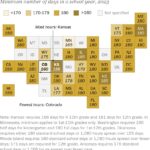Mold, a sneaky and often hidden intruder, can compromise your home’s structure and your family’s health. Early detection is key, but identifying mold, especially in its initial stages, requires a professional eye. While a higher price tag might seem daunting, a thorough mold inspection is an investment in your peace of mind. This guide breaks down the factors influencing the cost of a mold inspection, ensuring you understand what you’re paying for.
The cost of a mold inspection can vary significantly, typically ranging from $200 to $800 or more, depending on several factors. Let’s delve into the specifics that impact the final cost:
Home Size and Property Dimensions
The size of your home is a primary driver of mold inspection costs. Many inspectors charge by the hour, so larger properties naturally require more time and effort. A comprehensive inspection might involve the entire house, while in other cases, only specific areas like the basement or attic, known for water damage, need assessment. The larger the area, the higher the cost.
Accessibility of Suspected Areas
Accessibility plays a significant role in the final cost. Hard-to-reach areas demand more time and specialized techniques. Inspectors might need to remove drywall or tiles to gain access, leading to extra charges. A quick inspection of easily visible spots might take as little as two hours, while extensive checks in inaccessible areas can stretch to six hours or more. Here’s a breakdown:
- High Accessibility & Visibility: Bathroom walls, kitchen walls, exposed foundation walls.
- Medium Accessibility & Visibility: Windows, window sills, fireplaces, chimneys, enclosed attic spaces near the roof.
- Low Accessibility & Visibility: Air ducts and vents, crawl spaces, wall cavities (especially between drywall and foundation).
Number of Samples Required
The extent of mold contamination dictates the number of samples needed. If mold is present in multiple locations, each area requires individual testing. Furthermore, inspectors often take multiple samples to differentiate between mold types, such as the dangerous black mold versus other varieties. Some companies also impose a minimum number of samples, influencing the overall cost.
Types of Mold Samples
The type of sample collection significantly impacts the cost of a mold inspection. Some companies charge separately for visual inspections versus air quality assessments. Furthermore, suspected black mold often incurs higher costs due to the need for specialized protective equipment and handling procedures.
Here’s a breakdown of common mold testing types:
- Swab Test: $200 – $300. A surface sample is collected from areas with visible mold or suspected contamination. This method is best for identifying mold in a specific location but might require additional testing to assess the overall air quality.
- Air Test: $250 – $350 (can reach $700 for extensive testing). A basic air test is often included in an inspection, assessing mold spore concentration in the air to determine the severity of the issue room by room.
- HVAC Test: $50 – $75. Often added to an air test, this assesses mold infiltration within your home’s ventilation system. Given the potential for widespread contamination, it’s a worthwhile addition to any mold inspection.
Types of Lab Tests
Lab testing is crucial to identify the specific type of mold present, particularly whether it’s a toxic variety. This information guides remediation efforts. There are two primary lab test types, each adding to the overall cost:
- Stain Test: Approximately $150. Mold samples from swabs, tape, or air are treated with a stain to enhance visibility under a microscope, allowing technicians to analyze the mold structure.
- Mold Culture Test: Approximately $50. This test involves placing a mold sample in a controlled environment to encourage growth. The growth rate helps determine the severity of the mold issue and the urgency of remediation.
Mold Type and Associated Risks
The type of mold influences the inspection cost, with toxic molds like black mold often driving up prices. While general mold inspections typically range from $450 to $800, suspected black mold requires specialized handling and expedited processes, leading to higher costs.
Conclusion
Understanding the factors impacting mold inspection costs empowers you to make informed decisions. By considering home size, accessibility, sample types, and potential mold types, you can anticipate expenses and ensure a thorough assessment. Remember, a professional mold inspection is an investment in your health and home’s integrity, providing valuable insights for effective remediation.
